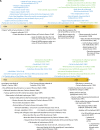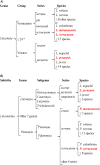Carrion's Disease: the Sound of Silence
- PMID: 29187394
- PMCID: PMC5740975
- DOI: 10.1128/CMR.00056-17
Carrion's Disease: the Sound of Silence
Abstract
Carrion's disease (CD) is a neglected biphasic vector-borne illness related to Bartonella bacilliformis. It is found in the Andean valleys and is transmitted mainly by members of the Lutzomyia genus but also by blood transfusions and from mother to child. The acute phase, Oroya fever, presents severe anemia and fever. The lethality is high in the absence of adequate treatment, despite the organism being susceptible to most antibiotics. Partial immunity is developed after infection by B. bacilliformis, resulting in high numbers of asymptomatic carriers. Following infection there is the chronic phase, Peruvian warts, involving abnormal proliferation of the endothelial cells. Despite potentially being eradicable, CD has been expanded due to human migration and geographical expansion of the vector. Moreover, in vitro studies have demonstrated the risk of the development of antimicrobial resistance. These findings, together with the description of new Bartonella species producing CD-like infections, the presence of undescribed potential vectors in new areas, the lack of adequate diagnostic tools and knowledge of the immunology and bacterial pathogenesis of CD, and poor international visibility, have led to the risk of increasing the potential expansion of resistant strains which will challenge current treatment schemes as well as the possible appearance of CD in areas where it is not endemic.
Keywords: Bartonella bacilliformis; Carrion's disease; Oroya fever; Peruvian warts.
Copyright © 2017 American Society for Microbiology.
Figures










References
-
- Allison MJ, Pezzia A, Gerszten E, Mendoza D. 1974. A case of Carrion's disease associated with human sacrifice from the Huari culture of southern Peru. Am J Phys Anthropol 41:295–300. - PubMed
-
- Strong RP, Tyzzer EE, Brues CT, Sellards AW, Gastiaburu JC. 1915. Report of first expedition to South America 1913. Harvard University Press, Cambridge, MA.
-
- Cook ND. 2004. Enfermedades en el mundo andino durante el siglo XVI, p 35–53. In Hernandez Palomo JJ. (ed), Enfermedad y muerte en América y Andalucía, siglos XVI–XX. CSIC Press, Madrid, Spain.
-
- Nowell CE. 1946. Aleixo Garcia and the white king. Hispanic Am Hist Rev 26:450–466. doi:10.2307/2507650. - DOI
Publication types
MeSH terms
Substances
LinkOut - more resources
Full Text Sources
Other Literature Sources

